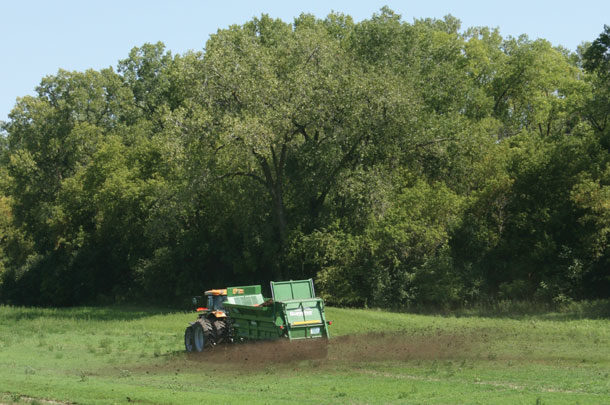The changing landscape of manure management is a change in mindset from manure being animal waste to a high-value contributor to the bottom line of the farm.
The days of treating manure like it was a waste product are gone. Whether it’s pen pack or slurry, it’s seeing the value in manure for its nutrient content and managing it like a resource instead of a waste product.
The often-changing environmental legislation in and of itself is enough to drive that change in perspective. There are a lot more rules specific to manure and manure handling that come into play these days, and picking the right manure spreader is, as much as anything, about getting the job done when you need to get it done in the allotted window of time.
Some of these rules involve restrictions controlling the time of year that farmers can spread. You are constrained by weather, as every farmer is, but in many locations you’re not permitted to spread manure in certain conditions. From a standpoint of choosing the right manure spreader, it’s probably important to know how big of a spreader you need to get the volume of manure spread in the timeframe you have to get it physically done.
The type of spreader you use is, of course, dependent on the kind of manure you’re handling. But if you have a small box spreader and have to make multiple trips, you may run out of time before you get the job done. What do you do with the other loads? That’s why we are seeing farmers migrating to larger box spreaders. In the industry overall, there’s a very clear trend to “mega-spreaders,” very high-capacity manure spreaders that allow you to get the job done in the time window you have available.
Then there’s the other side of the conversation, and that’s understanding that manure isn’t just a byproduct or waste. It brings nutrient value back to your soil. Understanding that, the days of just laying it on thick to dispose of it are gone. Overapplying is bad because you may need those nutrients elsewhere on the farm, where you will lose yield because of a nutrient deficiency or have to top-dress with fertilizer, which will increase your production costs.
You can actually sample manure and take it to a lab to understand what the nutrient content of that material is. Then you can soil sample and spread the manure appropriately across your ground and control the spread to distribute the nutrients to get the best value out of it. Putting too much manure down benefits no one. It’s not about getting rid of the manure; it’s about how I apply it to grow my next bumper crop.
When you sample manure to understand what the nutrient load of that material is, you can then apply it across your farm based on a prescription of the nutrient content. One of the important things a farmer can do is calibrate their manure spreader to see how much material they’re putting out at a given ground speed. It’s really no different than how you would calibrate a fertilizer spreader. It’s kind of an unsavory prospect to do because it involves putting tin roaster pans like you’d put a turkey in out in the field and then driving the manure spreader across them and weighing the material content of the pans. It helps you understand how far apart you need to be driving the spreader to get the best overlap for a consistent spread across the profile of the field.
Box spreaders typically put out a spread pattern as wide as the wheel track of the machine. They are pretty much a block, so it’s generally extremely consistent across that whole profile. For a vertical beater spreader, however, they tend to throw material out more heavily in the center than they do on the edges.
So if you’re running that type of machine, and you’re only throwing it from the left and the right just far enough to touch where the last pass ended, you’re not overlapping enough. Then you will have a variable nutrient load across your field that spikes in the middle and tapers to the side, then spikes again and so forth. With that type of machine, you’re better off to run the spreader so you have an overlap of the spread triangle, so you get better distribution of the material across the total profile of your fields.
Taking advantage of technology has come to manure spreaders to understand how much you’re spreading and using GPS tracking to know where you’re spreading, which is an important piece of compliance with government regulations. It benefits the producer by being able to better manage the nutrients across their farm. If you’re asked where you spread manure on your farm, you have the data at hand. You can prove exactly what you did, including the GPS coordinates of where you did the work.
So manure management is really not a simple question of picking the right manure spreader for your operation. It’s a much bigger conversation about the bottom line of your operation and compliance with current and future regulations.






